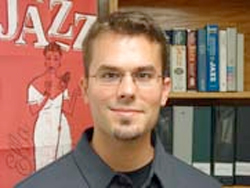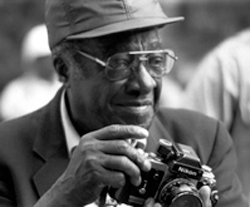by Mike Telin

Milt Hinton with Cab Calloway
This weekend, double bass students aged 13 to 21 will travel to the Oberlin Conservatory to be part of the Inaugural Milton J. Hinton Institute for Studio Bass. The weeklong institute provides the young players with the opportunity to study with renowned teachers in all musical genres including classical, early music, jazz, slap, Latin, and electric. A special feature of the inaugural institute will be a day-long celebration of Hinton’s long and distinguished career on Thursday, June 12.
The Institute is part of a new relationship between Oberlin and the Hinton estate which assures that the legacy of “The Dean of Jazz bassists” will be kept alive well into the future. Oberlin’s partnership with the Hinton estate was facilitated by Oberlin Professor of Jazz Studies and Double Bass Peter Dominguez and Special Collections Librarian Jeremy Smith.
The roots of Dominguez’s relationship with Hinton go back to 1979. “I was in a lesson with Richard Davis at the University of Wisconsin at Madison. Richard told me that Milt Hinton was starting a scholarship competition and he thought I would be a good candidate,” Dominguez said during a recent telephone conversation recalling his first encounter with Hinton. “I asked Richard a question about the competition, and he said, ‘well, I don’t know the answer to this. Hold on a second.’ Davis went over to the rotary phone and dialed a number and said ‘Hi Milt? I have a student here who has a question,’ and he handed the phone to me.” Dominguez went on to win that first scholarship competition.
As part of its new relationship with the Hinton estate, Oberlin was gifted the $250,000 Milton J. Hinton Scholarship Fund, established in 1980 by friends and family of Hinton on the occasion of his 70th birthday. “Can you imagine!” Dominguez exclaimed. “That just shows you where his thinking was. He gave so much, and now the Milt Hinton Institute will take place in perpetuity every two years.”
The daylong festival on Thursday, June 12, called “Celebrating Milt Hinton” begins at 2:30 p.m. with a guided tour of the Hinton estate collection as well as an exhibit of photographs documenting Hinton’s 70-year career.
At 4:30, the film Keeping Time: The Life, Music and Photographs of Milt Hinton will be screened at Oberlin’s Apollo Theatre. At 5:30, Hinton expert David Berger and principal guests of the Institute, including friends and colleagues of Milt Hinton, will join in a conversation about Hinton’s life.
The Celebration will culminate in an 8:00 pm performance in Warner Concert Hall. Four of Hinton’s basses which have been acquired by the Conservatory will be featured in performances by Richard Davis, John Clayton, Rufus Reid, Diana Gannett, Jerry Jemmott, Donovan Stokes, Philip Alejo, Scott Dixon and Peter Dominguez, who is director of the institute and festival.
The program will include works in a wide variety of genres by Milt Hinton, Ravel, J.S. Bach, Stefano Scodanibbio, Manuel Ponce, Stevie Wonder, Horacio Cabarcos, and Johnny Mandel, in addition to original works by Donovan Stokes and Rufus Reid.
One of the many things Dominguez admired about Milt Hinton was his willingness to help young bass players get their start in the music business. “I found out that when my teacher, Richard Davis, went to New York in his 20s, Milt basically took him through the studios to show him off and had him play all sorts of music. He helped so many people out. I’m a direct line from that, having received those same kinds of things from Richard Davis.”
Throughout his career Dominguez continued to stay in touch with Milt and his wife. “When Milt passed in 2000, I wrote a couple of letters to Mona. About two years ago I was in New York going through their archives and there were the letters. Mona kept everything.”
After the Bertram and Judith Kohl Building for Jazz Studies was opened in 2009 and Jeremy Smith had been hired as the Special Collections Librarian and Curator of the James and Susan Neumann Jazz Collection, Dominguez contacted David Berger, the executor of the Hinton estate, telling him that Oberlin might be the place to house Hinton’s archives.
“We brought David and Holly Maxson to Oberlin about three years ago. They thought about the idea and said yes. Oberlin met the criteria because Milt always said that he wanted his stuff to go to an educational institutions so that future generations could learn from it. He didn’t want it to be put in a museum and locked away.”
Jeremy Smith described The Milton J. and Mona C. Hinton papers as essentially all the materials compiled by the Hintons over the course of their lives. “Everything is there, including date books that both Milt and Mona kept documenting his day-to-day musical activities from the 1950’s until his death in 2000. They show who he was playing with and what recording sessions he was on. They obviously did this to keep his schedule organized and to make sure he was paid for all the gigs he played.”
The papers include correspondence between Hinton and other musicians as well as US presidents. “We have awards he was given, honorary doctorates he received and documents about streets that were named after him,” Smith said. “We also have concert programs from many performances he gave during his life. We have articles and newspaper clippings, financial records, contracts from when he was with Cab Calloway and even tax records. It’s really a thorough collection that documents a person who was one of jazz’s — and really music’s — most prolific recording artists of the twentieth century.”
In addition to being a great musician, Milt Hinton was also a noted photographer. “I believe Milt purchased his first camera in 1935, right before he went on the road with Cab Calloway,” Smith said. “There are over 60,000 black & white photos. He really captured a unique perspective of jazz musicians that other photographers didn’t have. He wasn’t an outsider coming in with a camera and setting up lights and being intrusive. He was just Milt hanging out in the studio and backstage. Oberlin does not own the photograph collection — it’s still administered by people associated with his estate — but we have a very good relationship with them.”
Smith, who holds a PhD from Duke University in Jazz History, said that every time he digs into the collection he learns more about Milt Hinton. “You can’t really study jazz without knowing him. But before I started to really look into his life and his papers I had no idea how stylistically diverse his musical contributions were. I associated him only with jazz and I didn’t have a clue that he had recorded with Barbara Streisand, Willy Nelson and Aretha Franklin. I didn’t know about the TV jingle side of his work either, and I was only moderately familiar with him as a photographer.”
After all the digging, has Smith been surprised by anything? “I knew what a legend he was and about all the awards he had won and all the accolades he had received. But you don’t understand the extent of his influence until you see handwritten letters from President Carter, until you open up his date book and read the names of every major musician — and these are just people who he called and chatted with.
“To see the accolades he received from the greatest jazz musicians and the greatest musicians beyond jazz as well; to see a letter from President Clinton thanking him for his contribution to American culture — it’s really quite remarkable. And that came alive for me through these artifacts in a way that it previously hadn’t.”
Published on ClevelandClassical.com June 6, 2014.
Click here for a printable copy of this article.






